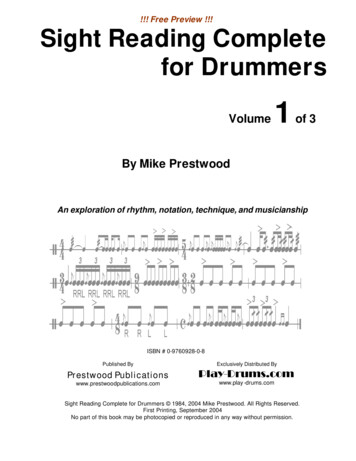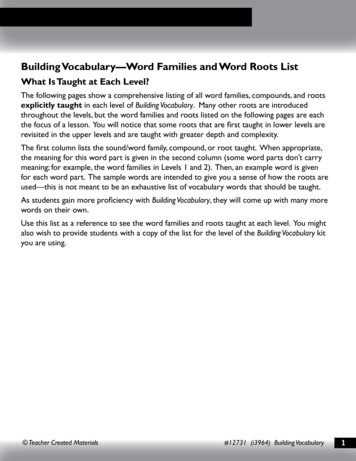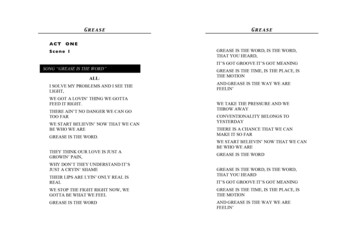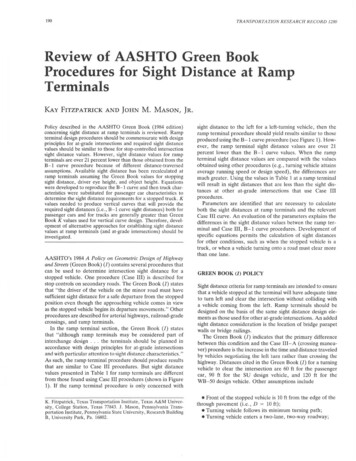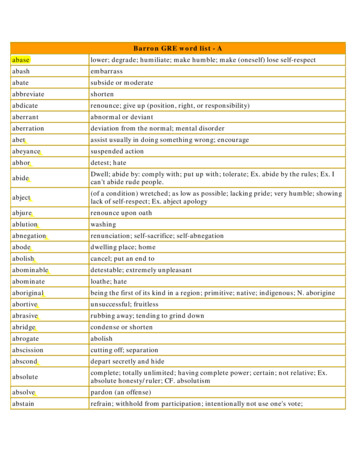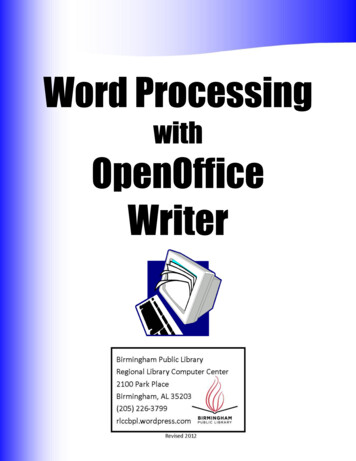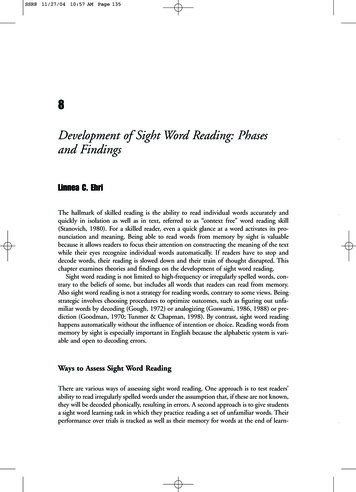
Transcription
SSR8 11/27/04 10:57 AM Page 1358Development of Sight Word Reading: Phasesand FindingsLinnea C. EhriThe hallmark of skilled reading is the ability to read individual words accurately andquickly in isolation as well as in text, referred to as “context free” word reading skill(Stanovich, 1980). For a skilled reader, even a quick glance at a word activates its pronunciation and meaning. Being able to read words from memory by sight is valuablebecause it allows readers to focus their attention on constructing the meaning of the textwhile their eyes recognize individual words automatically. If readers have to stop anddecode words, their reading is slowed down and their train of thought disrupted. Thischapter examines theories and findings on the development of sight word reading.Sight word reading is not limited to high-frequency or irregularly spelled words, contrary to the beliefs of some, but includes all words that readers can read from memory.Also sight word reading is not a strategy for reading words, contrary to some views. Beingstrategic involves choosing procedures to optimize outcomes, such as figuring out unfamiliar words by decoding (Gough, 1972) or analogizing (Goswami, 1986, 1988) or prediction (Goodman, 1970; Tunmer & Chapman, 1998). By contrast, sight word readinghappens automatically without the influence of intention or choice. Reading words frommemory by sight is especially important in English because the alphabetic system is variable and open to decoding errors.Ways to Assess Sight Word ReadingThere are various ways of assessing sight word reading. One approach is to test readers’ability to read irregularly spelled words under the assumption that, if these are not known,they will be decoded phonically, resulting in errors. A second approach is to give studentsa sight word learning task in which they practice reading a set of unfamiliar words. Theirperformance over trials is tracked as well as their memory for words at the end of learn-
SSR8 11/27/04 10:57 AM Page 136136Linnea C. Ehriing. This approach has been used to study whether readers retain specific words inmemory. Readers are taught one of two phonetically equivalent spellings (e.g., cake vs.caik) and then their memory for the particular form taught is tested. Readers might beasked to recall the spelling or to choose among alternative spellings. Although the test isof spelling rather than reading, the correlation between the two skills is very high, supporting the validity of spelling as an indicator. Finally, another approach is to assess wordreading speed. This works because readers take less time to read words by sight than todecode them or read them by analogy. Reading words within one second of seeing themis taken to indicate sight word reading.Automatic word recognition has been assessed with interference tasks. Written wordsand pseudowords are each imposed on drawings of objects; for example, cow or cos writtenon a picture of a horse. Students are told to name the pictures and ignore the print. If thewords are read automatically, readers will name pictures labeled with words more slowlythan those with pseudowords (Rosinski, Golinkoff, & Kukish, 1975). This happensbecause the familiar sight words are activated in memory and readers trip over these competing words as they access the names of the pictures. Tasks involving color words haveshown the same effects (e.g., word red written in blue ink). Researchers infer that wordsare known automatically if they create interference.Memory Processes That Enable Sight Word ReadingGrowth of reading skill requires the accumulation of a huge vocabulary of sight words inmemory. The magnitude of the task in English is suggested by Harris and Jacobson (1982)who tallied words that were common to at least half of eight basal series. This yielded acore list of basic words that did not count inflected forms such as stop and stopped separately. The list included 94 words from preprimers, with 175 from primer, 246 from firstgrade, and 908 from second-grade books. Thereafter, the numbers added at each gradelevel through eighth grade varied from 1,395 to 1,661 words, for a sum total of 10,240basic words. Thus, sight word learning makes a big demand on memory.Research findings reveal that sight words are established quickly in memory and arelasting. Reitsma (1983) gave Dutch first graders practice reading a set of words and thenthree days later measured their speed to read the original words as well as alternativespellings that were pronounced the same but never read (e.g., plezier vs. plesier). Aminimum of four trials reading the original words was sufficient to enable students toread the familiar forms faster than the unfamiliar forms. More recently, Share (2004)found that even one exposure to words enabled Israeli third graders to retain specific information about their spellings in memory, and this memory persisted a month later. Tolearn sight words this rapidly requires a powerful mnemonic system.When a reader’s eyes land on a familiar written word, its pronunciation, meaning, andsyntactic role are all activated in memory. Theories to explain how such memories are builtinvolve specifying the nature of the connections that are formed in memory to link visualproperties of the word to its other identities. Two types of connections have been proposed.According to one approach, connections are established between visual features ofwords and their meanings. These grapho-semantic connections are arbitrary rather than
SSR8 11/27/04 10:57 AM Page 137Development of Sight Word Reading: Phases and Findings137systematic. They are learned by rote. They do not involve letter-sound relations, so substantial practice is required to remember the words. The visuospatial features stored inmemory might be letters, letter patterns, word configurations, or length. However, nophonological information contributes to the associations. Rather pronunciations of wordsare activated only after the meanings of words have been retrieved. This explanation isadvanced by dual-route models of word reading with decoding as the other route (Baron,1979; Barron, 1986).According to another approach, spellings of specific words are connected to their pronunciations in memory. Readers use their knowledge of the alphabetic system to createthese connections. They know how to distinguish separate phonemes in pronunciationsand separate graphemes in spellings. They know grapheme–phoneme correspondences.More advanced readers know larger graphosyllabic units as well (e.g., -ing ). When readersencounter a new written word and recognize its pronunciation and meaning, they usetheir alphabetic knowledge to compute connections between graphemes and phonemes.Reading the word just once or a few times serves to bond the spelling to its pronunciation along with its other identities in memory. This is Ehri’s (1992) theory of sight wordreading. Others too have proposed visuophonological connectionist theories ofword reading (Harm & Seidenberg, 1999; Perfetti, 1992; Rack, Hulme, Snowling, &Wightman, 1994; Share, 1995).Visuophonological connections constitute a more powerful mnemonic system thatbetter explains the rapid learning of sight words than visuosemantic connections.However, both types appear in developmental theories. Grapho-semantic connectionsexplain the earliest forms of sight word reading. Once beginners acquire knowledge ofthe alphabetic system, graphophonemic connections take over.Developmental TheoriesThe development of word reading skill is portrayed as a succession of qualitatively distinct stages or phases in several theories. Use of the term “stage” denotes a strict view ofdevelopment in which one type of word reading occurs at each stage, and mastery is aprerequisite for movement to the next stage. However, none of the theories is this rigid.Some theories refer to “phases” rather than “stages” of development to be explicit aboutrelaxing these constraints. Earlier phases may occur by default because more advancedprocesses have not yet been acquired, so mastery is not necessarily a prerequisite for laterphases.These theories portray the succession of key processes and skills that emerge, change,and develop. Labels characterize the types of processes or skills that are acquired and predominate at each stage or phase. Theories may identify the causes producing movementfrom one phase to the next. Two types of causes can be distinguished, internal and external. Internal causes operate when specific cognitive or linguistic capabilities facilitate orplace constraints on the acquisition of other capabilities. Internal causes include capabilities specific to reading; for example, the facilitation produced by acquiring letter knowledge. Internal causes also include general capabilities that serve purposes other thanreading as well; for example, mechanisms involving vision, language, and memory (Rack,
SSR8 11/27/04 10:57 AM Page 138138Linnea C. EhriHulme, & Snowling, 1993). External causes include informal teaching, formal instructional programs, and reading practice. Theories provide a basis for assessing developmental levels, for predicting what students can be expected to learn at each level, fordifferentiating the types of instruction and feedback that are most effective at each level,and for explaining why some students do not make adequate progress.Synopsis of the TheoriesThe different stage and phase theories vary in scope and in the attention paid to sightword reading but there are also many similarities between them. There is not space inthis chapter to go into the different theories in detail. Table 8.1 represents an attempt tohighlight the synergies between the models as a backdrop to the discussion of sight wordreading.One of the first stage models was proposed by Philip Gough (Gough & Hillinger,1980; Gough, Juel, & Griffith, 1992) who distinguishes two ways to read words. Cuereading is an immature form of sight word reading. Students read words by selecting asalient visual cue in or around the word and associating it with the word in memory.Cipher reading replaces cue reading when students acquire decoding skill.Jana Mason (1980) divides Gough’s cue reading period into two stages labeled toportray the written cues that beginners use to identify written words: (1) contextualdependency, (2) visual recognition, and (3) letter-sound analysis. Context dependentlearners use the same learning process to recognize words as to identify pictures, by treating the words as unique visual patterns. Learners at the visual recognition stage use lettersto read words but they lack decoding skill. Learners at the letter-sound analysis stage havemastered letter-sound correspondences and can use them to decode unfamiliar words.Marsh, Friedman, Welch, and Desberg (1981) distinguish four stages characterized bychanges in the strategies to read words. During the earliest stage, known words are readby rote association between unanalyzed visual forms and their pronunciations. Unknownwords are read by linguistic guessing. During Stage 2, graphemic features, particularlyinitial letters, influence the reading of words. In learning to read words, readers remember the minimum graphemic cues necessary to distinguish among words. Stage 3 involvessequential decoding between letters and sounds. Stage 4 involves hierarchical decodingbased on more complex context-dependent rules. In addition, analogizing is consideredas a strategy for reading unknown words.Jeanne Chall (1983) differentiates the process of reading acquisition into five stagesfrom birth (Stage 0) through adulthood. Most relevant here are Stage 1 Decoding, andStage 2 Fluency. Stage 1 is further analyzed into phases. Initially children rely on memoryor contextual guessing to read. To make progress, they need to abandon these habits andbecome “glued to print” by processing letters and sounds. According to Chall this is facilitated by systematic phonics instruction.Uta Frith (1985) also noted that the transition between a visual and an alphabetic stagedepends on awareness of relationships between sounds and letters. Her proposal is a threephase theory characterized by different word reading strategies: (1) a logographic phase
2Number ofDevelopmentalPeriods1. Pre-readingCuereading Cipherreading 4. Fluentreading3. Decoding2. EarlyreadingGough iminationnetguessingVisualrecognitionRote, linguisticguessing43ContextualdependencyMarsh et al.(1981)Mason(1980)Stage 2:Fluency,ConsolidationStage 1:Decoding,attending toletters/soundsMemory andcontextualguessingStage 0:Letters/Bookexposure5Chall (1983)OrthographicAlphabeticLogographic3Frith beticPartialalphabeticPre-alphabetic4Ehri (1998,1999, 2002)2Stuart &Coltheart(1988)A Schematic Summary of the Approximate Relationships between Different Stage/Phase Theories of Learning to ReadPartialorthographicCompleteorthographic Dual FoundationPre-literacy4Seymour & ographic Table 8.1SSR8 11/27/04 10:57 AM Page 139
SSR8 11/27/04 10:57 AM Page 140140Linnea C. Ehriwhen readers recognize words on the basis of distinctive visual or contextual features;(2) an alphabetic phase when readers use spelling-sound rules to read words; (3) anorthographic phase when words are recognized by larger spelling patterns, especiallymorphemic units.Building on Frith’s model, Philip Seymour (Seymour & Duncan, 2001) proposes thedual-foundation model consisting of several phases of literacy development: pre-literacy,foundation, orthographic, and morphographic. In the foundation phase, two processesare acquired. The logographic process entails the accumulation of sight words in memory.In contrast to Frith’s (1985) nonalphabetic logographic phase, grapheme–phoneme unitsare used to connect words in memory. The alph
advanced by dual-route models of word reading with decoding as the other route (Baron, 1979; Barron, 1986). According to another approach, spellings of specific words are connected to their pro-nunciations in memory. Readers use their knowledge of the alphabetic system to create these connections. They know how to distinguish separate phonemes .
